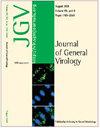翻译抑制和 mRNA 衰变是阿尔法疱疹病毒病毒宿主关闭蛋白的独立活动
IF 3.6
4区 医学
Q2 BIOTECHNOLOGY & APPLIED MICROBIOLOGY
引用次数: 0
摘要
单纯疱疹病毒 1(HSV1)病毒宿主关闭(vhs)蛋白是一种内切核酸酶,它通过细胞外切核酸酶活性诱导宿主 mRNA 的降解,从而调节感染细胞的翻译环境。为了进一步了解翻译关闭与 mRNA 降解之间的关系,我们利用异位表达将 HSV1 vhs(vhsH)与其他四种α-疱疹病毒的同源物进行了比较:水痘带状疱疹病毒(vhsV)、牛疱疹病毒 1(vhsB)、马疱疹病毒 1(vhsE)和马立克氏病病毒(vhsM)。只有 vhsH、vhsB 和 vhsE 能诱导荧光素酶 mRNA 报告基因的降解,poly(A)+ 原位杂交表明,在表达这些变体的细胞中,细胞质 poly(A)+ RNA 全球耗竭,同时细胞核 poly(A)+ RNA 和 polyA 尾结合蛋白 PABPC1 增加。相比之下,vhsV 和 vhsM 未能诱导报告基因 mRNA 的衰变和 poly(A)+ 的耗竭,反而诱导了细胞质 G3BP1 和含有颗粒的 poly(A)+ mRNA 以及应激反应蛋白 eIF2α 和蛋白激酶 R 的磷酸化。耐人寻味的是,不管它们的内切核酸酶活性如何,所有 vhs 同源物都能诱导等效的翻译总体阻滞,这是用单细胞嘌呤霉素掺入法测定的。总之,这些数据表明,vhs 诱导的翻译受阻和 mRNA 衰变活动是可分离的,我们认为它们代表了 vhs 宿主相互作用途径的连续步骤。本文章由计算机程序翻译,如有差异,请以英文原文为准。
Translational arrest and mRNA decay are independent activities of alphaherpesvirus virion host shutoff proteins
The herpes simplex virus 1 (HSV1) virion host shutoff (vhs) protein is an endoribonuclease that regulates the translational environment of the infected cell, by inducing the degradation of host mRNA via cellular exonuclease activity. To further understand the relationship between translational shutoff and mRNA decay, we have used ectopic expression to compare HSV1 vhs (vhsH) to its homologues from four other alphaherpesviruses – varicella zoster virus (vhsV), bovine herpesvirus 1 (vhsB), equine herpesvirus 1 (vhsE) and Marek’s disease virus (vhsM). Only vhsH, vhsB and vhsE induced degradation of a reporter luciferase mRNA, with poly(A)+ in
situ hybridization indicating a global depletion of cytoplasmic poly(A)+ RNA and a concomitant increase in nuclear poly(A)+ RNA and the polyA tail binding protein PABPC1 in cells expressing these variants. By contrast, vhsV and vhsM failed to induce reporter mRNA decay and poly(A)+ depletion, but rather, induced cytoplasmic G3BP1 and poly(A)+ mRNA- containing granules and phosphorylation of the stress response proteins eIF2α and protein kinase R. Intriguingly, regardless of their apparent endoribonuclease activity, all vhs homologues induced an equivalent general blockade to translation as measured by single-cell puromycin incorporation. Taken together, these data suggest that the activities of translational arrest and mRNA decay induced by vhs are separable and we propose that they represent sequential steps of the vhs host interaction pathway.
求助全文
通过发布文献求助,成功后即可免费获取论文全文。
去求助
来源期刊

Journal of General Virology
医学-病毒学
CiteScore
7.70
自引率
2.60%
发文量
91
审稿时长
3 months
期刊介绍:
JOURNAL OF GENERAL VIROLOGY (JGV), a journal of the Society for General Microbiology (SGM), publishes high-calibre research papers with high production standards, giving the journal a worldwide reputation for excellence and attracting an eminent audience.
 求助内容:
求助内容: 应助结果提醒方式:
应助结果提醒方式:


